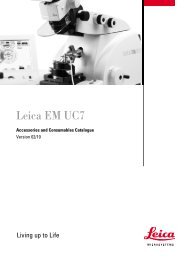Physical Principles of Electron Microscopy: An Introduction to TEM ...
Physical Principles of Electron Microscopy: An Introduction to TEM ...
Physical Principles of Electron Microscopy: An Introduction to TEM ...
Create successful ePaper yourself
Turn your PDF publications into a flip-book with our unique Google optimized e-Paper software.
174 Chapter 6<br />
A typical energy-loss spectrum (Fig. 6-10) contains a zero-loss peak,<br />
representing electrons that were scattered elastically or remained unscattered<br />
while passing through the specimen. Below 50 eV, one or more peaks<br />
represent inelastic scattering by outer-shell (valence or conduction) electrons<br />
in the specimen. This scattering can take the form <strong>of</strong> a collective oscillation<br />
(resonance) <strong>of</strong> many outer-shell electrons, known as a plasmon excitation.<br />
Inelastic excitation <strong>of</strong> inner-shell electrons causes an abrupt increase in<br />
electron intensity (an ionization edge) at an energy loss equal <strong>to</strong> an innershell<br />
ionization energy. Because this ionization energy is characteristic <strong>of</strong> a<br />
particular chemical element and is known for every electron shell, the energy<br />
<strong>of</strong> each ionization edge indicates which elements are present within the<br />
specimen. Beyond each ionization threshold, the spectral intensity decays<br />
more gradually <strong>to</strong>ward the (extrapolated) pre-edge background that arises<br />
from electron shells <strong>of</strong> lower ionization energy. The energy-loss intensity<br />
can be integrated over a region <strong>of</strong> typically 50 � 100 eV and the background<br />
component subtracted <strong>to</strong> give a signal IA that is proportional <strong>to</strong> the<br />
concentration <strong>of</strong> the element A that gives rise <strong>to</strong> the edge. In fact, the<br />
concentration ratio <strong>of</strong> two different elements (A , B) is given by:<br />
nA/nB = (IA/IB) (�B /�A) (6.11)<br />
where �A and �B are ionization cross sections that can be calculated,<br />
knowing the a<strong>to</strong>mic number, type <strong>of</strong> shell, and the integration range used for<br />
each<br />
element.<br />
Because the magnetic prism has focusing properties, an electron<br />
spectrometer can be incorporated in<strong>to</strong> the <strong>TEM</strong> imaging system and used <strong>to</strong><br />
form an image from electrons that have undergone a particular energy loss in<br />
the specimen. Choosing this energy loss <strong>to</strong> correspond <strong>to</strong> the ionization edge<br />
<strong>of</strong> a known element, it is possible <strong>to</strong> form an elemental map that represents<br />
the<br />
distribution <strong>of</strong> that element, with a spatial resolution down <strong>to</strong> about 1 nm.<br />
Other information is present in the low-loss region <strong>of</strong> the spectrum<br />
(below 50 eV). In a single-scattering approximation, the amount <strong>of</strong> inelastic<br />
scattering is proportional <strong>to</strong> specimen thickness, as in Eq. (4.16). Therefore,<br />
the intensity <strong>of</strong> the plasmon peak relative <strong>to</strong> the zero-loss peak (Fig. 6-10)<br />
can be used <strong>to</strong> measure the local thickness at a known location in a <strong>TEM</strong><br />
specimen.<br />
Also, the energy-loss spectrum contains detailed information about the<br />
a<strong>to</strong>mic arrangement and chemical bonding in the specimen, present in the<br />
form <strong>of</strong> fine structure in the low loss region and the ionization edges. For<br />
example, the intensities <strong>of</strong> the two sharp peaks at the onset <strong>of</strong> the Ba M-edge<br />
in Fig. 6-10 can be used <strong>to</strong> determine the charge state (valency) <strong>of</strong> the<br />
barium a<strong>to</strong>ms. For further details, see Brydson (2001) and Eger<strong>to</strong>n (1996).



